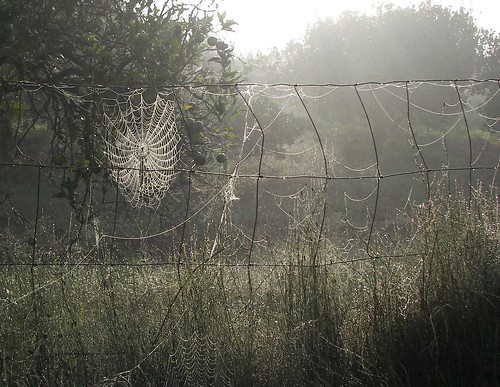› Forums › Yurara Fameliki’s Stories › The Faded Cabbage Tavern › Snowflakes of Tens › Reply To: Snowflakes of Tens

Whether or not Arachne was actually better at weaving than Athena is still a mystery, or perhaps it is a moot point and no mystery at all. Weaving is by no means a solitary endeavour, as Blithe found early one summer morning. The river mist was rising and the air itself was dancing in droplets. It was hard to determine if the droplets were falling or rising, or simply milling around on the air currents. Hard green oranges (clearly oranges had been named in winter, or they would likely have been called greens) were festooned with silver threads, linking orange to orange, orange to tree and tree to wire fence, and back again. It was debatable whether or not the individual spiders were aware of the grand overall design of the early morning web links of the orange groves, just as it was equally debatable whether or not the inhabitants of the various Gibber realities were aware of the network of waterpipes that connected the other inhabitants to themselves and each other, and to the other Gibber worlds. Individuals were individuals, whether they be spiders, or Gibblets, and individuals generally speaking were focused on their own part of the tapestry (and often those of their immediate neighbours). Spider 57 on the east fence might be positioned to catch the first rays of sunshine in the mornings, but Spider 486,971 over near the dung heap was in a better position to catch the afternoon flies. And so on, as somebody famous once said.
As Blithe prowled around the orchard capturing potential clues on her Clumera she inevitably became part of the laybrinthine web of sticky threads herself, as they attached themselves to her hair and clothing. All of the gaps between the solids in the field were joined together with spun filaments, just as the Gibblets were joined together with fun spillaments (although leaking waterpipes were sadly misinterpreted as not-fun all too often, despite that they could be used as an opportunity to view the connections of the Waterpunk more comprehensively.)
The individual spiders lacy parlours were framed in wire squares, several hundred, if not more, along the perimeter fences. Not every wire fence square was filled; there were many vacant lots between established residences ~ whether by practical design or mere happenstance, Blithe couldn’t say. Many of the individual webs were whole and perfect, like the windows of Lower Gibber whose inhabitants kept their lace curtains clean and neatly hung. Many of the webs on the wire fence were not perfect in the symetrical sense ~ some had gaping holes, and there were those that appeared to be unfinished, despite showing great potential. Others appeared to be abandoned, hanging in shreds, not unlike many of the residences in Upper Gibber.
The wire framed residences of the field (and likewise the peeling paint framed residences of Upper Gibber) that appeared to be defunct were not quite as they seemed, however. They were simply being viewed from a different timeframe. It was quite possible to view each wire or peeled paint framed en-trance side by side, notwithstanding that they were, so to speak, located in varying timeframes. All that was required was a more flexible viewpoint, and an ability to view more than one timeframe simultaneously. It was all a question of allowing an entrance to en-trance ~ which was, after all, its function.
{link: misty morning; entrance}